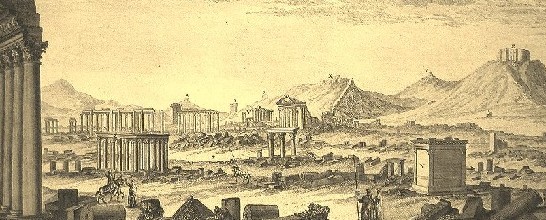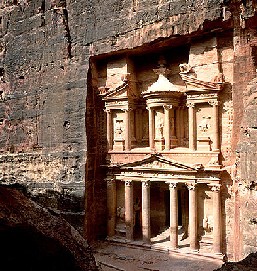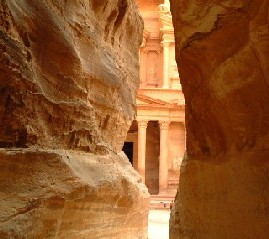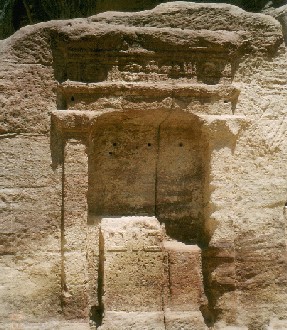|
From the earliest times, much before the dawn of recorded history,
two great cities flourished in the desert. One of them
was hidden in rocks of a mountain and the other stood
out in the open desert. Nobody from the outside world
knew about their existence until they were, at the begin
of modern times, accidentally discovered by explorers
who chanced upon their splendid ruins totally by
surprise during their travels in the desert. These ruins
speak eloquently about the vast wealth and power of the
long-dead citizens of the two mystique cities. Where did
that wealth come from that has enabled the people of
these two cities to live their lives in such luxury, and
the leisure to build such magnificent cities, the likes
of which have been never seen in this world? The amazing
ruins of these two wonderful cities are now being coaxed
by the spade to yield their long-held secrets; and the
spade of the archeologist is slowly revealing the
amazing history of the two nations, which were ranked
among the most powerful of the world during their times.
The city of Petra stands in the Jordanian desert, and lies in a
valley that runs from the Gulf of Aqabah to the Red Sea,
in the heart of the massive mountain of Petra, shut away
from the prying eyes of the outside world. At first
sight, one will find the city to be unapproachable. In
order to travel to the ruins of Petra, one has to go
through a narrow crevice in the rocks, and the passage
will turn and twist downhill for a mile getting narrower
as people travel through it, with rocks of the mountains
bearing down menacingly from every side on the traveler,
blocking out the sun. Then, just as the traveler has
given up all hope of seeing the city, he will catch the
first glimpse of the enormous, imposing columns carved
into the mountain rock through an opening at the edge of
the passage. Suddenly, the traveler will emerge into
bright sunlight to stand before a breathtaking, awesome
sight of a huge city, of enormous houses and buildings
all carved into the walls of the mountainside. At first
sight, one could be deceived into believing that he has
come across one of the old Roman cities that has long
been forgotten by the outside world. But on closer
examination, he finds though the architecture of the
enormous city resemble Roman architecture, there is an
elaborate detail in its settings, which is not found
among the ruins of the other great Roman cities.
Moreover, the city stands in the hollow of a mountain
mass in an isolated valley in Jordan, totally out of
place and out of its time.
According to the archeologists, the fantastic buildings in the
extraordinary city of Petra were probably built and
inhabited sometime in the first and second century
before the beginning of the Common Era. One of the
largest and most important buildings in the city was
perhaps the Treasury, because of a sculptured urn that
stands on its top, which is believed to be filled with
gold. In fact, this belief is so powerful that the urn
is completely ridden with bullet holes by treasure
hunters seeking to acquire the gold.
Beyond the Treasury, there is another narrow valley, which leads a
visitor to the main city of Petra that is filled with
hundreds of buildings, temples and tombs. Some of the
buildings appear plain, whereas others are decorated
with obelisks, pillars and cornices all done up in a
variety of styles. This lost city withstood the ravages
of time and the savage wind carrying fine sand over the
centuries that destroyed the details of the external
carvings on the buildings, but this is compensated by
the splendid hue of colors, in which the city is seen
during different times of the day. From distance, the
city looks pink in color, but on approaching it the
buildings take on a golden yellow or a light purple
color. From afar it appears, as if they are painted by a
master-artists with huge brushes dripping in bright
colors across a huge oil canvas, on drawings of huge
buildings and carved pillars.
Petra was unknown to the world for nearly a thousand years, except
perhaps to the nomadic Bedouin tribesmen passing that
way, until it was discovered by Johann Ludwig Burckhardt,
a Swiss explorer, who had set out alone on a journey
through Arab lands in 1809, after studying Arabic. He
mapped this uncharted territory and unlocked its secrets
to the outside world. In order to make his travel in the
Arab lands easy, and partly because of his genuine
attraction to the Muslim way of life and its culture, he
disguised himself as an Arab and took an assumed name of
Ibrahim ibn Abdallah. He had in his studies acquired a
good knowledge of Islam and its rituals and followed
them scrupulously to avoid suspicion and detection as a
non-Muslim among the Arab tribes. He had earlier spent
two years in Syria, visiting some of its ancient ruins
and cities, and on his way to Palestine, he first heard
of an amazing city hidden deep among the mountains of
the Jordan valley. The Arabs believed the existence of a
tomb of Prophet Aaron (Harun), the brother of Prophet
Moses (Musa) on a hill near the ancient city veiled to
the outside world.



Intrigued, he declared his intention of making a sacrifice at the
tomb of the Prophet Harun to his guide, which was near
the site of the ruins. His guide, after some persuasion,
agreed to lead him to this place. Making their way
across the hostile desert, Burckhardt along with his
goat and the guide, advanced through the valley that led
to the city of Petra. At first sight, he was
wonderstruck at the magnificent splendor of the city.
However, he overcame his awe, and paused to examine in
detail several monuments in the city, covertly taking
notes and making sketches in a notebook that he carried
with him. By the time he reached by foot the mountain
that held the Prophet's tomb, it was dark and he had to
sacrifice the goat at the bottom of the mount and
returned to the camp without making the climb to the
top.
Burckhardt's book was published in 1822, five years after his death
in Egypt. However, before its publication the city of
Petra had been rediscovered by other European explorers,
and their finding created a sensation in the West. Soon
Petra became a favorite destination spot for tourists,
adventurers and serious scholars. To the archeologists,
the city offered a fascinating puzzle, for the
architecture of the buildings carved in the rock showed
the influence of all the ancient buildings found in
Syria, Egypt, Greece and Rome.
Since, 1958, a more
serious work, done by British excavators has revealed
the extraordinary culture and history of the people who
once inhabited this place.
The Nabateans are credited for building the city of Petra. However,
before them, this area was occupied by other people
known as Edomites, who were continuously on hostile
terms with the other neighboring states. They occupied
an important part of the region, which was on the
crossroads of several important trade routes and
profited immensely from the trade caravans that passed
their way. It is believed that the Edomites were
defeated by the Jews under King Solomon, and their rule
extended to this area for the next two hundred years.
Later, the Babylonians conquered the Jews and led them
into captivity. The Edomites who had been expelled from
this area started to move in to reoccupy the lands,
which were formerly under their control. However, this
area was again invaded, this time by the Nabateans, a
nomadic, pastoral tribe of Arab origins. They integrated
easily with the Edomites in this area to lead a more
settled life. By the year 300 BCE, the Nabateans
appeared to have gained a complete control of the area
and constructed for themselves the first urban
settlement by carving their living quarters, buildings
and tombs in the rocks of the nearby mountains. At the
peak of their prosperity in the 1st century BCE, the
city of Petra had as many as 30,000 inhabitants. They
were governed by a king from 168 BCE and formed a state
that resembled a democratic state, where the king was
held accountable for all his actions.

Water was scarce in this region and it was highly prized. The chief
deity of this city was Al Uzza, and she was also the
deity of springs and water. The Nabateans used the water
available to them ingeniously to farm the surrounding
desert lands and developed Petra into an oasis
throughout the year. They spoke a language that was
similar to Ahramaic. They produced beautiful pottery and
splendid architecture, some of which was influenced - in
the later days - by the Roman style. By the first
century CE, the city of Petra became again a center of
trade because of the continuous wars fought between
Egypt and Syria. Soon, the Nabateans became rich and
powerful enough to extend their control to an area,
which reached to the north of Damascus. As they became
wealthier, the style of living improved, which in turn,
was reflected by the rich decorations on the tombs of
the later day Nabateans. One of the buildings that
excelled all others in its grandeur, elegance and
majesty, was
Deir,
the Monastery, which was 138 feet high and cut deeply
into mountain rock, with a large plain before it to
conduct their religious rituals, which contained some
elements of animal and human sacrifice.
By the year 196 CE, the Romans had annexed Petra and it became a
Roman province. In the past, the Nabateans had made rich
profits from Roman trade with India and Arabia that was
conducted in their lands. After conquering Petra, the
trade routes came under the control of Rome. The Romans
started constructing their own buildings in Petra, and
provided the city with an amphitheater that had room for
4000 spectators and constructed a temple - Kasr al Bint -
the only free standing structure in the heart of the
city, where the great marketplace was located. It was
here, where caravans from the East traded with others in
the West in spices, ivory, amber and bales of cloth.
Petra continued to be an important trading center for
the next two centuries. However, its importance waned
steadily with the other cities such as Palmyra in the
north started attracting trade. Gradually, the merchants
left, and along with them left the Roman legions whose
duty was to guard the trade routes. After the Roman
Empire converted into Christianity, the city of Petra
acquired a bishop and a few of its buildings were
converted into churches. But the city - ruled from
Byzantium - had lost its earlier significance and left
to its own devices.
Before the arrival of Muslim rule in the seventh century, the city
of Petra was struck by a severe earthquake causing the
few inhabitants to desert the city completely. But, with
the sketchy details, and the absence of a clear record
of Nabatean history, it will forever remain a mystery to
understand the significance of some of the ruins in the
city of Petra and will make it impossible for anybody to
unravel the mystique that still surrounds this city.
Three hundred miles to the north of the city of Petra stands the
city of Palmyra, which is now completely in ruins. In
contrast to Petra, this city stands on open ground and
is visible for miles in the open desert, and is located
about 140 miles east of Damascus. Its huge columns and
colonnades and many of the skeletons of its vanished
buildings stand as a mute sentinel of the past and
visitors have been overwhelmed for centuries by the huge
magnificent ruins of this city.
Most of Palmyra's magnificence can be traced back to the second
century CE, when it had reached its peak and prosperity
as a trading center. However, recent records of
excavations have traced its history to nearly 2000 BCE,
when this city was an oasis called Tadmor, which was the
original name for Palmyra, and its current name came
from the Romans who had occupied the city. For thousands
of years, this area was occupied by the Arab nomadic
tribes who had started leading a settled way of life. In
time, they adopted the language of the Aramaeans,
another Semitic tribe of Arab origins. For many
centuries, the city of Palmyra was a modest and
prosperous town. Later, the Roman and Greek influences
in the first century CE transformed this sleepy town
giving it a grandeur, which can be seen among its
remains in the present day. With the growth of
long-distance trade the city began attracting traders
from Persia, India and China to the east and the
Phoenicians from the west. Traders could do business at
this mutually convenient meeting point in ivory, spices,
silk, gold and jewels saving both on time and wasted
effort by journeying far to other trading routes. The
people of Palmyra levied a tax on the traders and
offered them a place to carry on their trade, and
provided them with fresh water and accommodation, which
in turn, added to their prosperity. In fact, the city of
Palmyra became the first city in that region to be known
as a "nation of shopkeepers."
Some idea of their wealth can be gleaned by the rich adornments
worn by the surviving statues of women of Palmyra and
the amount of wealth lavished on decorating the tombs of
the dead, which clearly belonged to the rich in the
city. Others were buried in desert graves marked with
modest headstones. The most imposing feature of the city
is the Great Colonnade, which was built in the second
century CE. It consisted of more than seven hundred
columns, measuring 29 feet in height, crowned with
intricate designed heads, and formed the main
thoroughfare of the city lined with shops and trading
offices.

Near the end of the colonnades stand the ruins of a great temple of
Bel, the supreme deity of Palmyra. Here, the priests
sacrificed animals to the idols of greater and lesser
deities kept in the temple and held regular feasts in
their honor. The city continued to thrive under Roman
patronage for a time, which continued to add on to its
prosperity. However, by the middle of third century CE,
Syria was invaded by Persia, and successfully blocked
all trade routes to Palmyra. The citizens of Palmyra
were left with no choice but to come to terms with the
enemy or fight them without Roman help. At this point in
time, a leading Senator of Palmyra by name Odenathus
entered the scene to deal with the crisis. He tried to
buy peace with the Persians but all his attempts were
rebuffed. In the end, he set about the task of raising
an army to fight the Persians and enlisted recruits from
all over Syria and fashioned them into a disciplined
army. Then, he took on the might of the Persians and
defeated them decisively, and declared himself the King
of Palmyra. With his help, Rome regained its influence
in the Middle East and recognized Palmyra as an
independent state.
Odenathus did not rule for long. He was assassinated in 268 CE and
was succeeded by his beautiful wife Zenobia who ruled
Palmyra on behalf of her infant son Vallabathus.
Historians of the past relate that she was an
extraordinary woman who was both, brave and intelligent.
She was an expert horsewoman, extremely ambitious and
wanted to build an empire of her own. Determined to
release Palmyra from Roman influence and its status as a
vassal state, she marched against Antioch in 271 CE and
captured the important Mediterranean Port. Next, she
sent her army to Egypt, which emerged victorious from
the expedition, and gave her son the title of Augustus -
a title, which was used only by the Roman Emperor - and
started minting her own currency.
By this time, Rome was ruled by a new Emperor, Aurelian, who, after
settling all his border disputes with Germany, marched
with his army to Antioch to curb the growing menace and
the increasing power of Palmyra and defeated the army of
Zenobia, which was stationed there. After suffering
another decisive defeat at the hands of the Romans, at a
place eighty miles from Palmyra, Zenobia retreated
hastily with her generals to the city, and started
fortifying its walls.
When the Roman Emperor reached Palmyra, he found the city
well-defended. Faced with a superior Roman army, Zenobia
appealed to Persia for help, but it never came. Emperor
Aurelian settled his army for a long siege near Palmyra.
He offered peace and exile to Zenobia, but she rejected
his terms. The siege dragged on. The Roman army had
organized well-supplied lines for its army, but the
people of Palmyra were starving for food. In this
desperate situation, Zenobia decided to escape the siege
by riding on a dromedary in a daring dash in the night
in the desert crossing the Roman army lines. She managed
to reach Euphrates before being overtaken, and
was captured by the Roman army sent in her pursuit.
After Zenobia was taken into captivity, the citizens of Palmyra
surrendered. The Roman Emperor entered the city, had
some of the important people of the city killed and then
brought a trail against Zenobia. Fearing for her own
life and of her son, Zenobia blamed her advisors for her
military misadventures against the might of the Roman
Empire. Her advisors were executed by the Romans and
that spared the lives of Zenobia and her son.
Some historians relate that Zenobia committed suicide unable to
bear the humiliation after her defeat. Others say that
she was taken into Rome in a triumphal procession,
decked in all her royal jewels with her hands, feet and
a gold collar around her neck, all bound together in
shackles of gold. According to another account, the
Emperor Aurelian had her married to a Roman senator
where she lived a comfortable life with her family until
the end of her life.
Meanwhile, the people of Palmyra regrouped and made another attempt
to win independence from Roman rule, but this uprising
was quickly put to an end by Rome. However, this time
Emperor Aurelian had the city sacked. After this
military defeat, the importance of Palmyra rapidly
declined, both as a city and an important trading
center.
In the seventh century, the Muslims easily conquered the city and
tried to reclaim the destroyed building stones for their
own constructions. Gradually the city of Palmyra ceased
to be of any importance to the Muslims and its decline
continued until the city was completely deserted by all
its inhabitants.
When Western travelers reached Palmyra in the 17th century they
found a small tribe of Arabs living in the ruins of the
city in huts made up of mud. A mosque had been
constructed in the temple of Bel and was there until
1929. Today, the only inhabitants of Palmyra are the
archeologists with their spades, trying topiece together
the history of this once-magnificent city. |
